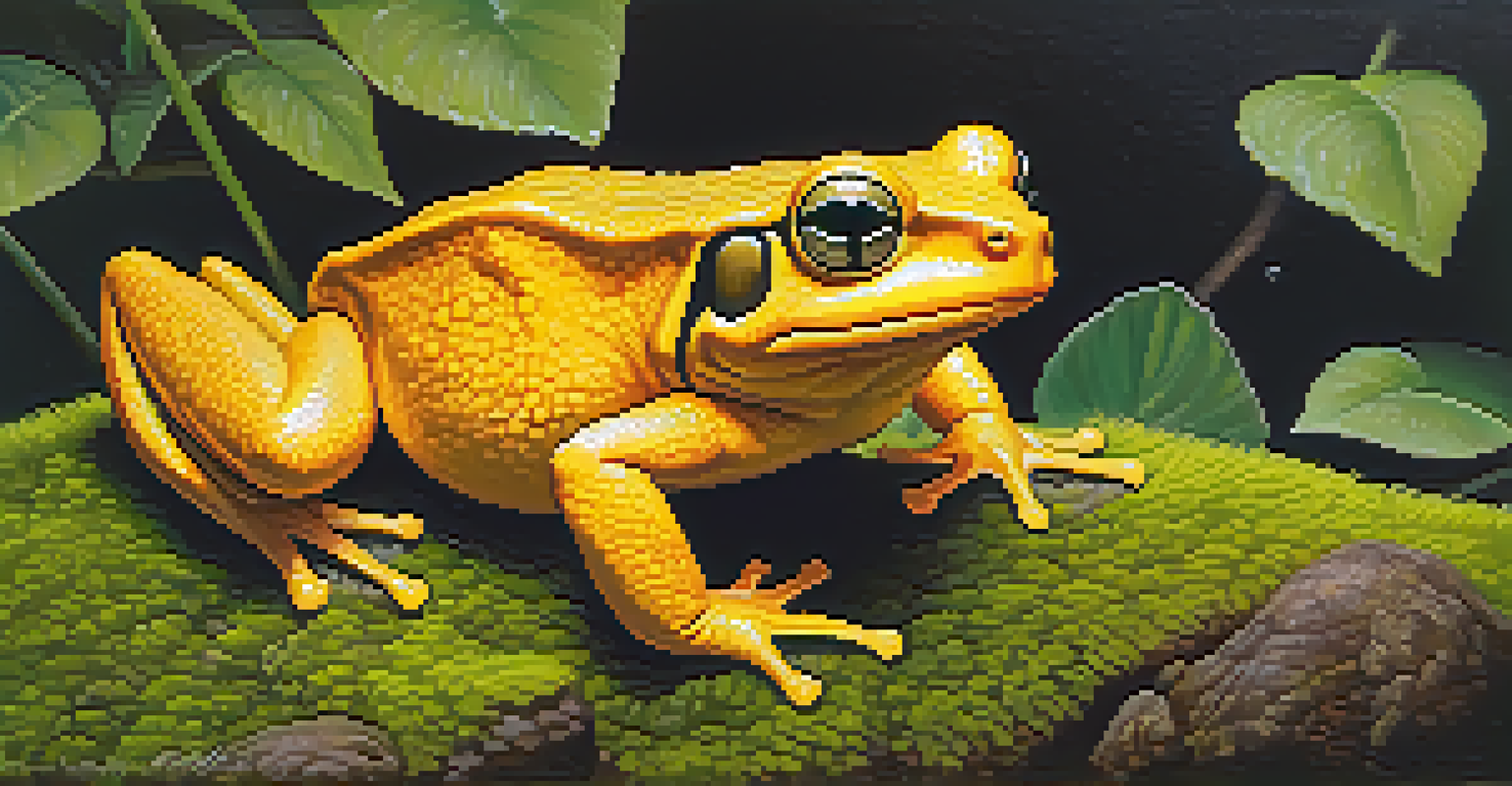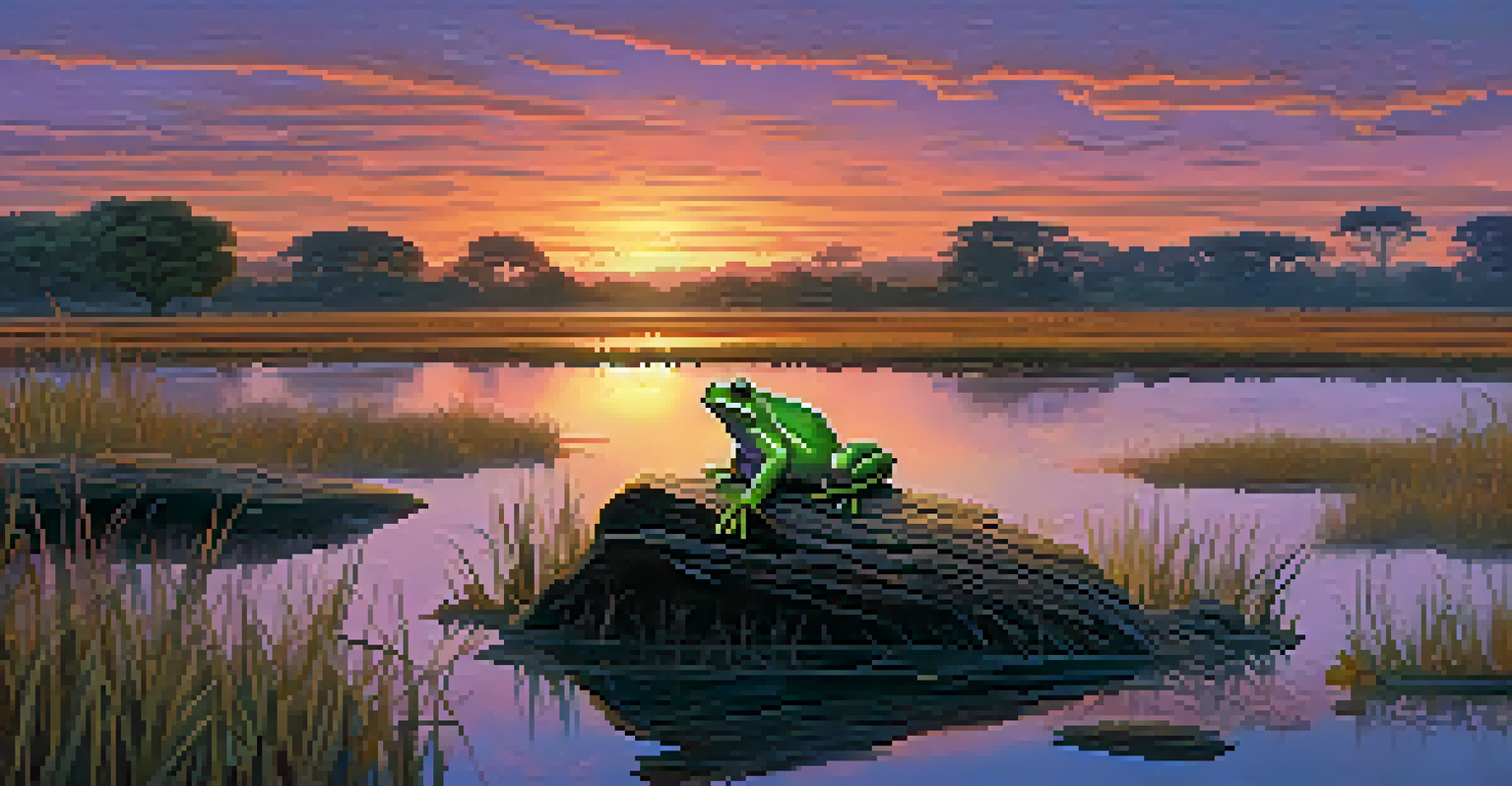Exploring Brazil's Unique Amphibian Species and Their Habitats

Brazil: A Biodiversity Hotspot for Amphibians
Brazil is renowned for its rich biodiversity, and when it comes to amphibians, it's nothing short of extraordinary. With over 1,000 species of frogs, toads, and salamanders, the country represents a significant portion of the world's amphibian diversity. This variety is largely attributed to Brazil's diverse ecosystems, ranging from the Amazon rainforest to the Pantanal wetlands.
The greatest threat to our planet is the belief that someone else will save it.
Each ecosystem hosts unique species adapted to their specific environments. For instance, the Amazon rainforest is home to the vibrant poison dart frogs, famous for their brilliant colors and toxic skin. Meanwhile, the Pantanal boasts species like the giant Brazilian toad, which thrives in its vast, seasonal wetlands.
However, this incredible diversity is under threat from habitat destruction and climate change. Protecting these unique amphibians and their habitats is crucial not only for their survival but also for maintaining the ecological balance of Brazil's ecosystems.
The Amazon Rainforest: A Amphibian Paradise
The Amazon rainforest serves as a primary habitat for many of Brazil's amphibian species. Its humid, lush environment provides the perfect breeding ground for frogs and toads, offering both food and shelter. For example, the colorful Amazonian poison frog thrives in this tropical setting, showcasing remarkable adaptations to its vibrant surroundings.

In addition to the poison frogs, the Amazon is home to various tree frogs that exhibit fascinating behaviors. Some species, like the red-eyed tree frog, are known for their striking appearance and unique reproductive strategies, laying eggs on leaves above water bodies to protect them from predators.
Brazil's Amphibians Are Diverse
With over 1,000 species, Brazil boasts an extraordinary variety of amphibians across its unique ecosystems.
However, with deforestation and pollution on the rise, these amphibians face increasing challenges to their survival. Efforts are being made to conserve the Amazon and its unique biodiversity, but raising awareness about these species and their habitats is vital for their protection.
The Atlantic Forest: A Unique Ecosystem
The Atlantic Forest, stretching along Brazil's southeastern coast, is another crucial habitat for amphibians. This ecosystem is known for its high levels of endemism, meaning many species are found nowhere else on Earth. Here, you can find the critically endangered golden toad, which has become a symbol of the forest's fragility.
In nature's economy, the currency is not money; it is life.
The unique climate and geography of the Atlantic Forest create various microhabitats, allowing diverse amphibian species to thrive. For example, the tiny Brazilian tree frog can be spotted perched on leaves, while the larger, more elusive black-and-white frog prefers the forest floor, showcasing the adaptability of these creatures.
Sadly, urbanization and agricultural expansion have drastically reduced this habitat, putting pressure on the amphibian populations. Conservation initiatives are vital to restore and protect the Atlantic Forest, ensuring the survival of its unique amphibian species.
The Pantanal: Wetlands and Amphibians
The Pantanal, the world's largest tropical wetland, is a vital habitat for many amphibians. This vast ecosystem is characterized by seasonal flooding, creating a dynamic environment where species like the giant Brazilian toad thrive. These toads have adapted to the changing water levels, showcasing their resilience in the face of environmental shifts.
In addition to the giant Brazilian toad, the Pantanal is home to a variety of other amphibians, including the strikingly patterned marsh frog. These frogs are well-suited to the wetlands, often found near pools and streams, where they hunt for insects and other small prey.
Threats Endanger Amphibian Species
Habitat destruction, climate change, and pollution pose significant risks to Brazil's amphibian populations.
However, the Pantanal is facing challenges from climate change and agriculture, threatening the delicate balance of this ecosystem. Protecting these wetlands is essential not only for the amphibians that inhabit them but also for the overall health of Brazil's environment.
Unique Adaptations of Brazilian Amphibians
Brazil's amphibians exhibit a range of fascinating adaptations that help them survive in their diverse habitats. For instance, many species have developed vibrant colors as a warning to potential predators about their toxicity. This bright coloration is not just for show; it plays a critical role in their survival.
Another interesting adaptation can be seen in the Brazilian horned frog, which is known for its incredible camouflage. With its flattened body and leaf-like appearance, it can easily blend into the forest floor, making it nearly invisible to both predators and prey.
Such adaptations highlight the intricate relationship between amphibians and their environments. As these species evolve to survive, they also contribute to the overall ecosystem by controlling insect populations and serving as indicators of environmental health.
Threats Facing Brazil's Amphibian Species
Despite their resilience, Brazil's amphibian species face numerous threats, primarily due to human activities. Habitat destruction from deforestation, urban development, and agriculture has dramatically reduced their living spaces, pushing many species toward extinction. For example, the golden toad of the Atlantic Forest has seen its numbers dwindle due to habitat loss.
Additionally, climate change poses significant risks, altering rainfall patterns and temperatures. These changes can disrupt breeding cycles and food availability, making it harder for amphibians to survive. The ongoing use of pesticides and pollution further exacerbates these challenges, impacting both their habitats and health.
Conservation Efforts Show Promise
Ongoing conservation initiatives and community involvement are crucial for protecting Brazil's unique amphibians and their habitats.
Efforts are being made to mitigate these threats, such as creating protected areas and promoting sustainable practices. However, it requires collective action and awareness to ensure the future of Brazil's unique amphibians.
Conservation Efforts and Success Stories
Fortunately, there are various conservation efforts underway to protect Brazil's amphibian species and their habitats. Organizations are working tirelessly to create protected areas, restore habitats, and raise awareness about the importance of biodiversity. One notable success story is the reintroduction program for the golden toad, which has seen some positive results in its population recovery.
Additionally, local communities are becoming increasingly involved in conservation efforts. Educating residents about the significance of amphibians and their ecosystems has led to grassroots initiatives aimed at protecting these species. Collaboration between scientists, governments, and communities is crucial for the long-term success of these efforts.

While challenges remain, these conservation initiatives demonstrate that positive change is possible. By prioritizing the protection of Brazil's amphibians, we can ensure that future generations enjoy the beauty and diversity of these remarkable creatures.